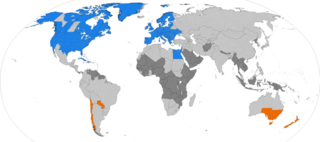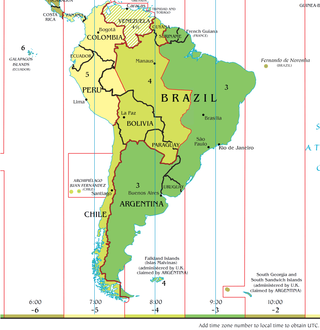Related Research Articles

Daylight saving time (DST), also referred to as daylight saving(s), daylight savings time, daylight time (United States and Canada), or summer time (United Kingdom, European Union, and others), is the practice of advancing clocks to make better use of the longer daylight available during summer so that darkness falls at a later clock time. The typical implementation of DST is to set clocks forward by one hour in spring or late winter, and to set clocks back by one hour to standard time in the autumn (or fall in North American English, hence the mnemonic: "spring forward and fall back").

Western European Summer Time is a summer daylight saving time scheme, 1 hour ahead of Greenwich Mean Time and Coordinated Universal Time. It is used in:

The North American Central Time Zone (CT) is a time zone in parts of Canada, the United States, Mexico, Central America and some Caribbean islands.

Summer time in Europe is the variation of standard clock time that is applied in most European countries in the period between spring and autumn, during which clocks are advanced by one hour from the time observed in the rest of the year, with a view to making the most efficient use of seasonal daylight. It corresponds to the notion and practice of daylight saving time (DST) to be found in some other parts of the world.

The time in China follows a single standard time offset of UTC+08:00 based on the National Time Service Center of Chinese Academy of Sciences located in Mount Li, Lintong District, Xi'an City, Shaanxi Province, even though the country spans five geographical time zones. The official national standard time is called Beijing Time domestically because it is based on the 120th meridian east, where Beijing City is located, and China Standard Time (CST) internationally. Daylight saving time has not been observed since 1991. China Standard Time (UTC+8) is consistent across Mainland China, Hong Kong, Macau, Taiwan, as well as equivalent with Philippines, Singapore, Brunei, most of Mongolia, Malaysia, Irkutsk Time (Russia), Western Australia and Central Indonesia.
Time in Chile is divided into three time zones. Most of Continental Chile uses the time offset UTC−04:00 in winter time and UTC−03:00 in summer time, while the Magallanes and Chilean Antarctica region uses the time offset UTC−03:00 the whole year. Additionally, Easter Island uses the time offset UTC−06:00 in winter time and UTC−05:00 in summer time.

Argentina is located at a longitude that would naturally put it in the UTC−04:00 or UTC−05:00 time zone; however, it actually uses the UTC−03:00 time zone. Argentina determines whether to change clocks in observation of daylight saving time on a year-by-year basis, and individual provinces may opt out of the federal decision. At present, Argentina does not change clocks.

Mexico uses four time zones:
Most of Mexico no longer observes daylight saving time as it was abolished on Sunday, 30 October 2022. The exceptions are the entire state of Baja California, as well as the border municipalities in Chihuahua, Coahuila, Nuevo León, and Tamaulipas which still observe daylight savings time matching the schedule of the United States beginning on the second Sunday of March and ending on the first Sunday of November.
Brazil observed daylight saving time (DST) in the years of 1931–1933, 1949–1953, 1963–1968 and 1985–2019. Initially it applied to the whole country, but from 1988 it applied only to part of the country, usually the southern regions, where DST is more useful due to a larger seasonal variation in daylight duration.
Paraguay observes UTC−04:00 for standard time (PYT), and UTC−03:00 for daylight saving time/summer time (PYST).
Since 2004, Uruguay had usually observed daylight saving time. Starting in 2006, DST begins on the first Sunday in October and ends on the second Sunday in March of every year. Time zone changed from Standard Time Zone UTC−03:00 to UTC−02:00.
Daylight saving time in the Americas is the arrangement in the Americas by which clocks are advanced by one hour in spring and moved back in autumn, to make the most of seasonal daylight. The practice is widespread in North America, with most of Canada and the United States participating, but much less so in Central and South America.

African countries, apart from Egypt, do not use daylight saving time (DST) although some did in the past. Only the territories of the Canary Islands, Ceuta and Melilla (Spain) and Madeira (Portugal) implement DST from the last Sunday in March to the last Sunday in October. Although these regions politically belong to Europe, they are geographically part of Africa. They have DST schedules according to European Union rules.

Portugal has two time zones and observes daylight saving time. Continental Portugal and Madeira use UTC+00:00, while the Azores use UTC–01:00. Daylight saving time is observed nationwide from the last Sunday in March to the last Sunday in October, when continental Portugal and Madeira advance one hour to UTC+01:00, and the Azores advances one hour to UTC+00:00.

Daylight saving time (DST), also known as summer time, is the practice of advancing clocks during part of the year, typically by one hour around spring and summer, so that daylight ends at a later time of the day. As of 2024, DST is observed in most of Europe, most of North America and parts of Africa and Asia around the Northern Hemisphere summer, and in parts of South America and Oceania around the Southern Hemisphere summer. It was also formerly observed in other areas.
Spain has two time zones. Spain mainly uses CET (UTC+01:00) in Peninsular Spain, Ceuta, Melilla and the plazas de soberanía. In the Canary Islands, the time zone is WET (UTC±00:00).

La usurpadora is a Mexican television series produced by Carmen Armendáriz for Televisa. It is a reboot based on the 1998 Mexican telenovela of the same name and the first series of the anthology series Fábrica de sueños. In the series, the character Paola Miranda, the First Lady of Mexico, discovers she has a twin sister and tries to swap lives with her.
The 2022 Copa Bolivia was the 28th edition of the Copa Bolivia, Bolivia's domestic football cup competition organized by the Bolivian Football Federation (FBF), held for the first time since 2002. Ninety-four teams from the División Profesional and regional leagues were slated to take part in the competition, which started on 21 April with its regional preliminary stages and was scheduled to end on 3 November 2022.
Guatemala observes Central Standard Time (UTC−6) year-round.
References
- ↑ Desde el 1 de septiembre de 2011, los relojes de los bolivianos deberán ser modificados, en una hora. (in spanish)
- ↑ Pearce, Chris (2017-04-06). The Great Daylight Saving Time Controversy. Australian eBook Publisher. ISBN 978-1-925516-96-8.
- ↑ Bolivia adelantará la hora por primera vez en septiembre de 2011 (in spanish)
- ↑ Se posterga cambio de huso horario en Bolivia Archived 2011-12-09 at the Wayback Machine (in spanish)
